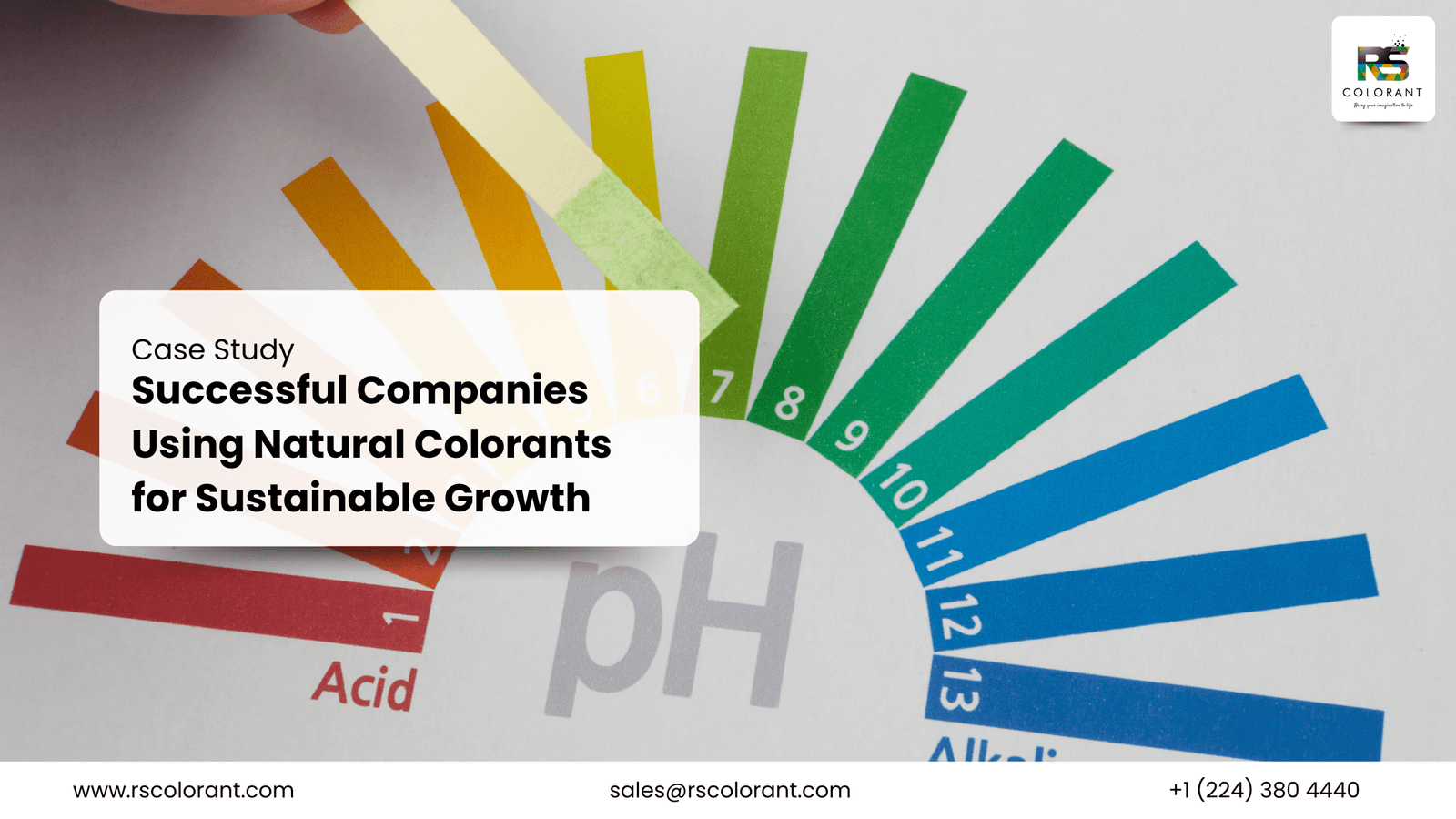Successful Companies Using Natural Colorants – Outline
- Introduction
- Overview of natural colorants
- Importance of natural colorants in the modern market
- What Are Natural Colorants?
- Definition and types
- Differences between natural and synthetic colorants
- The Rise of Natural Colorants in the Industry
- Historical perspective
- Current market trends
- Benefits of Using Natural Colorants
- Health benefits
- Environmental impact
- Consumer preferences
- Challenges of Natural Colorants
- Stability and consistency
- Cost implications
- Regulatory hurdles
- Case Study 1: Nestlé
- Background on Nestlé
- Implementation of natural colorants
- Results and impact
- Case Study 2: Lush Cosmetics
- Background on Lush Cosmetics
- Natural colorants in their product lines
- Outcomes and customer response
- Case Study 3: Ben & Jerry’s
- Background on Ben & Jerry’s
- Transition to natural colorants
- Success stories and challenges
- Case Study 4: Starbucks
- Background on Starbucks
- Use of natural colorants in beverages
- Market reception and benefits
- Technological Innovations in Natural Colorants
- Advances in extraction and processing
- Future trends
- Consumer Behavior and Natural Colorants
- Shifts in consumer demand
- Influence of social media and influencers
- Sustainability and Natural Colorants
- Role in sustainable practices
- Corporate social responsibility
- Future Prospects for Natural Colorants
- Predictions for market growth
- Potential for new industries
- Conclusion
- Recap of key points
- Final thoughts on the importance of natural colorants
- FAQs
- What are natural colorants?
- Are natural colorants safe?
- Why are companies switching to natural colorants?
- How do natural colorants impact the environment?
- What are the future trends in natural colorants?
Case Study: Successful Companies Using Natural Colorants
Introduction
In recent years, there’s been a noticeable shift towards the use of natural colorants in various industries. Consumers are becoming increasingly health-conscious and environmentally aware, leading companies to rethink their use of synthetic additives. This article explores the journey of successful companies that have adopted natural colorants, examining their motivations, strategies, and outcomes.
What Are Natural Colorants?
Natural colorants are dyes or pigments derived from natural sources such as plants, minerals, and insects. Unlike synthetic colorants, which are chemically manufactured, natural colorants are obtained through extraction and purification processes. Examples include carotenoids from carrots, anthocyanins from berries, and chlorophyll from green plants.
Differences Between Natural and Synthetic Colorants
Natural colorants tend to be perceived as safer and more environmentally friendly compared to their synthetic counterparts, which are often linked to health concerns and environmental pollution. While synthetic colorants offer consistency and vibrant hues, natural colorants provide a cleaner, more sustainable alternative.
The Rise of Natural Colorants in the Industry
The use of natural colorants dates back centuries, but their resurgence in the modern market is driven by growing health awareness and environmental sustainability. Historical records show that ancient civilizations used natural dyes for textiles, cosmetics, and food. Today, the market trends reflect a similar preference, with a significant push towards “clean label” products.
Benefits of Using Natural Colorants
Health Benefits
Natural colorants are generally considered safer, as they are less likely to contain harmful chemicals that can cause allergies or other health issues. This makes them particularly appealing in food and cosmetic industries where consumer health is a priority.
Environmental Impact
The extraction and use of natural colorants typically result in lower environmental pollution. Unlike synthetic colorants, which can produce hazardous waste, natural colorants are biodegradable and often sourced from renewable resources.
Consumer Preferences
Today’s consumers are more informed and selective about the products they use. There is a growing demand for transparency and natural ingredients, making natural colorants a key selling point for brands aiming to attract health-conscious customers.
Challenges of Natural Colorants
Stability and Consistency
One of the primary challenges with natural colorants is achieving stability and consistency. Natural dyes can be sensitive to light, pH, and temperature, which may affect the final product’s appearance and shelf life.
Cost Implications
Natural colorants can be more expensive to produce and procure compared to synthetic alternatives. The cost factor can be a significant barrier, especially for small and medium-sized enterprises.
Regulatory Hurdles
Navigating the regulatory landscape for natural colorants can be complex. Companies must ensure compliance with food and safety standards, which can vary significantly across regions.
Case Study 1: Nestlé
Background on Nestlé
Nestlé, a global food and beverage leader, has been at the forefront of the transition towards natural ingredients. Known for its commitment to quality and innovation, Nestlé’s move to natural colorants aligns with its broader sustainability goals.
Implementation of Natural Colorants
Nestlé has gradually phased out synthetic colorants from its products, replacing them with natural alternatives. This transition involved extensive research and development to ensure that the natural colorants met the company’s high standards for quality and consistency.
Results and Impact
The shift to natural colorants has been well-received by consumers, contributing to an enhanced brand image and customer loyalty. Nestlé’s products now boast cleaner labels, aligning with the growing consumer demand for transparency and natural ingredients.
Case Study 2: Lush Cosmetics
Background on Lush Cosmetics
Lush Cosmetics, renowned for its ethical and environmentally friendly products, has long championed the use of natural ingredients. The company’s vibrant and visually appealing products are often colored using natural dyes.
Natural Colorants in Their Product Lines
Lush utilizes a variety of natural colorants, including henna, turmeric, and beetroot powder, across its range of soaps, bath bombs, and cosmetics. These natural ingredients not only provide beautiful hues but also offer additional skin benefits.
Outcomes and Customer Response
Customers appreciate Lush’s commitment to natural and ethical products, leading to strong brand loyalty and positive market reception. The use of natural colorants has enhanced Lush’s reputation as a pioneer in sustainable beauty.
Case Study 3: Ben & Jerry’s
Background on Ben & Jerry’s
Ben & Jerry’s, the popular ice cream brand, is known for its innovative flavors and commitment to social responsibility. The company has embraced natural colorants to align with its values of sustainability and quality.
Transition to Natural Colorants
Ben & Jerry’s made a deliberate shift from synthetic to natural colorants, driven by consumer demand and the company’s own environmental commitments. This transition required significant adjustments in their production processes to maintain flavor and visual appeal.
Success Stories and Challenges
The transition has been successful, with positive feedback from consumers who value the natural ingredients. However, the company faced challenges in maintaining color consistency across batches, a common issue with natural dyes.
Case Study 4: Starbucks
Background on Starbucks
Starbucks, the global coffee giant, has also joined the movement towards natural ingredients. The company’s use of natural colorants reflects its broader efforts to promote sustainability and meet consumer preferences.
Use of Natural Colorants in Beverages
Starbucks has incorporated natural colorants in various beverages, including its popular seasonal drinks. Ingredients like beet juice and spirulina are used to achieve vibrant colors without synthetic additives.
Market Reception and Benefits
The introduction of naturally colored beverages has been well-received by Starbucks customers, who appreciate the healthier and more natural options. This move has also reinforced Starbucks’ brand image as a leader in innovation and sustainability.
Technological Innovations in Natural Colorants
Advances in technology have significantly improved the extraction and processing of natural colorants. Innovations such as fermentation and enzymatic processes have enhanced the stability and vibrancy of natural dyes, making them more viable for widespread use.
Consumer Behavior and Natural Colorants
Consumer demand for natural products is on the rise, influenced by increasing awareness of health and environmental issues. Social media and influencers play a crucial role in shaping these preferences, driving the popularity of products with natural ingredients.
Sustainability and Natural Colorants
Natural colorants contribute to sustainability by reducing reliance on synthetic chemicals and minimizing environmental impact. Companies using natural dyes often emphasize their commitment to sustainable practices, appealing to eco-conscious consumers.
Future Prospects for Natural Colorants
The market for natural colorants is expected to grow, driven by technological advancements and consumer demand. New industries, such as textiles and packaging, are exploring the potential of natural dyes, promising exciting developments in the future.
Conclusion
The shift towards natural colorants represents a significant trend in various industries, reflecting broader changes in consumer preferences and sustainability practices. Companies like Nestlé, Lush Cosmetics, Ben & Jerry’s, and Starbucks are leading the way, demonstrating the benefits and challenges of this transition. As technology continues to evolve, the future of natural colorants looks promising, with potential for even greater impact.
FAQs
What are natural colorants?
Natural colorants are dyes or pigments derived from natural sources such as plants, minerals, and insects, used as alternatives to synthetic colorants.
Are natural colorants safe?
Yes, natural colorants are generally considered safer than synthetic ones, as they are less likely to contain harmful chemicals.
Why are companies switching to natural colorants?
Companies are switching to natural colorants to meet consumer demand for healthier, more sustainable products and to enhance their brand image.
How do natural colorants impact the environment?
Natural colorants are typically more environmentally friendly, as they are biodegradable and sourced from renewable resources, reducing pollution compared to synthetic colorants.
What are the future trends in natural colorants?
Future trends include technological advancements to improve stability and vibrancy, increased use in various industries, and growing market demand driven by consumer preferences for natural and sustainable products.




